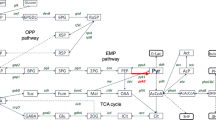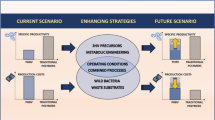Abstract
The biosynthesis of polyhydroxyalkanoates (PHAs) was studied, for the first time, in the thermophilic bacterium Thermus thermophilus. Using sodium gluconate (1.5% w/v) or sodium octanoate (10 mM) as sole carbon sources, PHAs were accumulated to approximately 35 or 40% of the cellular dry weight, respectively. Gas chromatographic analysis of PHA isolated from gluconate-grown cells showed that the polyester (Mw: 480,000 g.mol−1) was mainly composed of 3-hydroxydecanoate (3HD) with a molar fraction of 64%. In addition, 3-hydroxyoctanoate (3HO), 3-hydroxyvalerate (3HV) and 3-hydroxybutyrate (3HB) occurred as constituents. In contrast, the polyester (Mw: 391,000 g mol−1) from octanoate-grown cells was composed of 24.5 mol% 3HB, 5.4 mol% 3HO, 12.3 mol% 3-hydroxynonanoate (3HN), 14.6 mol% 3HD, 35.4 mol% 3-hydroxyundecanoate (3HUD) and 7.8 mol% 3-hydroxydodecanoate (3HDD). Activities of PHA synthase, a β-ketothiolase and an NADPH-dependent reductase were detected in the soluble cytosolic fraction obtained from gluconate-grown cells of T. thermophilus. The soluble PHA synthase was purified 4271-fold with 8.5% recovery from gluconate-grown cells, presenting a Km of 0.25 mM for 3HB-CoA. The optimal temperature of PHA synthase activity was about 70°C and acts optimally at pH near 7.3. PHA synthase activity was inhibited 50% with 25 μM CoA and lost all of its activity when it was treated with alkaline phosphatase. PHA synthase, in contrary to other reported PHA synthases did not exhibit a lag phase on its kinetics, when low concentration of the enzyme was used. Incubation of PHA synthase with 1 mM N-ethyl-maleimide inhibits the enzyme 56%, indicating that cysteine might be involved in the catalytic site of the enzyme. Acetyl phosphate (10 mM) activated both the native and the dephosphorylated enzyme. A major protein (55 kDa) was detected by SDS-PAGE. When a partially purified preparation was analyzed on native PAGE the major band exhibiting PHA synthase activity was eluted from the gel and analyzed further on SDS-PAGE, presenting the first purification of a PHA synthase from a thermophilic microorganism.
Similar content being viewed by others
References
Byrom D: Polyhydroxyalkanoates. In: D.P. Mobley (ed). Plastics from Microbes: Microbial Synthesis of Polymers and Polymers Precursors. Hanser, Munich, 1994, pp 5-33
Steinbüchel A: Polyhydroxyalkanoic acids. In: D. Byrom (ed). Biomaterials: Novel Materials from Biological Sources. Stockton, New York, 1991, pp 124-213
Lee SY: Bacterial polyhydroxyalkanoates. Biotechnol Bioeng 49: 1-14, 1995
Niehaus F, Bertoldo C, Kähler M, Antranikian G: Extremophiles as a source of novel enzymes for industrial application. Appl Microbiol Biotechnol 51: 711-729, 1999
Pantazaki AA, Pritsa AA, Kyriakidis DA: Biotechnologically relevant enzymes from Thermus thermophilus. Appl Microbiol Biotechnol 58: 1-12, 2002
Vieille C, Zeikus JG: Thermozymes: Identifying molecular determinants of protein structural and functional stability. Trends Biotechnol 14: 183-192, 1996
Lütke-Eversloh T, Bergander K, Luftmann H, Steinbüchel A: Identification of a new class of biopolymer: bacterial synthesis of a sulfur-containing polymer with thioester linkages. Microbiology 147: 11-19, 2001
Rehm BHA, Steinbüchel A: Biochemical and genetic analysis of PHA synthases and other proteins required for PHA synthesis. Int J Biol Macromol 25: 3-19, 1999
Steinbüchel A, Valentin HE: Diversity of microbial polyhydroxyalkanoic acids. FEMS Microbiol Lett 128: 219-228, 1995
Rehm BHA, Steinbüchel A: Synthases-the key enzymes of PHA synthesis. In: A. Steinbüchel, Y. Doi (eds). Biopolymers. Wiley, YCH, Heidelberg, Germany, 2001, pp 173-209
Gerngross TU, Snell KD, Peoples O P, Sinskey AJ, Csuhai E, Masamune S, Stubbe J: Overexpression and purification of the soluble polyhydroxyalkanoates synthase from Alcaligenes eutrophus: Evidence for a required posttranslational modification for catalytic activity. Biochemistry 33: 9311-9320, 1994
Liebergesell M, Sonomoto K, Madkour M, Mayer F, Steinbüchel A: Purification and characterization of the poly(hydroxyalkanoic acid) synthase from Chromatium vinosum and localization of the enzyme at the surface of poly(hydroxyalkanoic acid) granules. Eur J Biochem 226: 71-80, 1994
Qi Q, Steinbüchel A, Rehm BHA: In vitro synthesis of poly(3-hydroxydecanoate): Purification and enzymatic characterization of type II polyhydroxyalkanoate synthases PhaC1 and PhaC2 from Pseudomonas aeruginosa. Appl Microbiol Biotechnol 54: 37-43, 2000
Rehm BHA, Qi Q, Beermann BB, Hinz HJ, Steinbuchel A: Matrix-assisted in vitro refolding of Pseudomonas aeruginosa class II polyhydroxyalkanoate synthase from inclusion bodies produced in recombinant Escherichia coli. Biochem J 358: 263-268, 2001
Jossek R, Reichelt R, Steinbuchel A: In vitro biosynthesis of poly(3-hydrobutyric acid) by using purified poly(hydroxyalkanoic acid) synthase of Chromatium vinosum. Appl Microbiol Biotechnol 49: 258-266, 1998
Steinbüchel A, Hustede M, Liebergesell M, Pieper U, Timm A, Valentin H: Molecular basis for biosynthesis and accumulation of polyhydroxyalkanoic acid in bacteria. FEMS Microbiol Rev 103: 217-230, 1992
Antonio RV, Steinbüchel A, Rehm BHA: Analysis of in vivo substrate specificity of the PHA synthase from Ralstonia eutropha: Formation of novel copolyesters in recombinant Escherichia coli. FEMS Microbiol Lett 182: 111-117, 2000
Wodzinska J, Snell KD, Rhomberg A, Sinskey AJ, Biemann K, Stubbe J: Polyhydroxybutyrate synthase: Evidence for covalent catalysis. J Am Chem Soc 118: 6319-6320, 1996
Huisman GW, Wonink E, Meima R, Kazemier B, Terpstra P, Witholt B: Metabolism of poly(3-hydroxyalkanoates) (PHAs) by Pseudomonas oleovorans. Identification and sequences of genes and function of the encoded proteins in the synthesis and degradation of PHA. J Biol Chem 266: 2191-2198, 1991
Langenbach S, Rehm BHA, Steinbüchel A: Functional expression of the PHA synthase gene phaC1 from Pseudomonas aeruginosa in Escherichia coli results in poly(3-hydroxyalkanoate) synthesis. FEMS Microbiol Lett 150: 303-309, 1997
Qi Q, Steinbüchel A, Rehm BHA: Metabolic routing towards polyhydroxyalkanoic acid synthesis in recombinant Escherichia coli (fadR): Inhibition of fatty acid beta-oxidation by acrylic acid. FEMS Microbiol Lett 167: 89-94, 1998
Rehm BHA, Krüger N, Steinbüchel A: A new metabolic link between fatty acid de novo synthesis and polyhydroxyalkanoic acid synthesis. The phaG gene from Pseudomonas putida KT2440 encodes a 3-hydroxyacyl-acyl carrier protein-coenzyme A tranferase. J Biol Chem 273: 24044-24051, 1998
Jia Y, Yuan W, Wodzinska J, York G, Park C, Sinskey AJ: Mechanistic paradigms for class I and class III polyhydroxybutyrate synthases. The 8th Annual International Symposium on Biological Polyesters (ISBP 2000), 2000
Oshima T, Imahori K: Description of Thermus thermophilus, com. nov., a non sporulating thermophilic bacterium from a Japanese thermal spring. Int J Syst Bacteriol 24: 102-112, 1974
Brock TD. In: N.R. Krieg, J.G. Holt (eds). Bergey's Manual of Systematic Bacteriology, vol. 1. Williams & Wilkins, 1969, pp 333-339
Bradford MM: A rapid and sensitive method for the quantitation of microgram quantities of protein utilizing the principle of protein-dye binding. Anal Biochem 72: 248-254, 1976
Hahn SK, Chang YK, Kim BS, Chang HN: Optimization of microbial poly(3-hydroxybutyrate) recovery using dispersions of sodium hypochloride solution and chloroform. Biotechnol Bioeng 44: 256-261, 1994
Wieczorek R Steinbuchel A, Schmidt B: Occurence of polyhydroxyalkanoic acid granule-associated proteins related to the Alkaligenes eutrophus H16 GA24 protein in other bacteria. FEMS Microbiol Lett 135: 23-30, 1996
Müh U, Sinskey AJ, Kirby DP, Lane WS, and Stubbe J: PHA synthase from Chromatium vinosum: Cysteine 149 is involved in covalent catalysis. Biochemistry 38: 826-837, 1999
Ploux O, Masamune S, Walsh CT: The NADPH-linked acetoacetyl-CoA reductase from Zoogloea ramigera. Characterization and mechanistic studies of the cloned enzyme over-produced in Escherichia coli. Eur J Biochem 174: 177-182, 1988
Davis JT, Moore RN, Imperiali B, Pratt AJ, Kobayashi K, Masamune S, Sinskey AJ, Walsh CT: Biosynthetic thiolase from Zoogloea ramigera. I. Preliminary characterization and analysis of proton transfer reaction. J Biol Chem 262: 82-89, 1987
Laemmli UK: Cleavage of structural proteins during the assembly of the head of bacteriophage T4. Nature 227: 680-685, 1970
Brandl H, Gross RA, Lenz RW, Fuller RC: Pseudomonas oleovorans as a source of poly(β-hydroxyalkanoates) for potential applications as biodegradable polyesters. Appl Environ Microbiol 54: 1977-1982, 1988
Fukui T, Yoshimoto A, Matsumoto M, Hosokawa S, Saito T, Nishikawa H, Tomita K: Enzymatic synthesis of poly-β-hydroxybutyrate in Zoogloea ramigera. Arch Microbiol 110: 149-156, 1976
Haywood GW, Anderson AJ, Dawes EA: The importance of PHB-synthase substrate specificity in polyhydroxyalkanoate synthesis by Alcaligenes eutrophus. FEMS Microbiol Lett 57: 1-6, 1989
Timm A, Steinbüchel A: Formation of polyesters consisting of medium-chain-length 3-hydroxyalkanoic acids from gluconate by Pseudomonas aeruginosa and other fluorescent pseudomonads. Appl Environ Microbiol 56: 3360-3367, 1990
Matsusaki H, Manji S, Taguchi K, Kato M, Fukui T, Doi Y: Cloning and molecular analysis of the poly(3-hydroxybutyrate) and poly(3-hydroxybutyrate-co-hydroxyalkanoate) biosynthesis genes in Pseudomonas sp. strain 61-3. J Bacteriol 180: 6459-6467, 1998
Steinbüchel A, Schlegel HG: Physiology and molecular genetics of poly(β-hydroxy-alkanoic acid) synthesis in Alcaligenes eutrophus. Mol Microbiol 5: 535-42, 1991
Gerngross TU, Martin DP: Enzyme-catalysed synthesis of poly[(R)-(−)-hydroxybutyrate]: Formation of macroscopic granules in vitro. Proc Natl Acad Sci USA 92: 6279-6283, 1995
Miyake M, Kataoka K, Shirai M, Asada Y: Control of poly-β-hydroxybutyrate synthase mediated by acetyl phosphate in cyanobacteria. J Bacteriol 179: 5009-5013, 1997
Tomita K, Saito T, Fukui T: In: D. Leeon, F. Stratman, R. Zahlten (eds). Biochemistry of Metabolic Processes. Elsevier Press, Holland, 1983, p 353
Author information
Authors and Affiliations
Rights and permissions
About this article
Cite this article
Pantazaki, A.A., Tambaka, M.G., Langlois, V. et al. Polyhydroxyalkanoate (PHA) biosynthesis in Thermus thermophilus: Purification and biochemical properties of PHA synthase. Mol Cell Biochem 254, 173–183 (2003). https://doi.org/10.1023/A:1027373100955
Issue Date:
DOI: https://doi.org/10.1023/A:1027373100955




